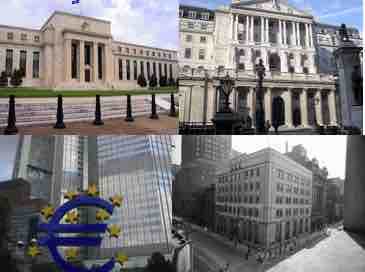A nation's money supply is determined by the monetary policy actions of its central bank. Examples of Central Banks include the Federal Reserve, the Bank of England, and the Bank of Canada, shown here . Commercial banks, as required by the central bank, must keep a fraction of all accepted deposits on reserve either in bank vaults or in central bank deposits. Accordingly, a nation's central bank can maintain control of such reserves by lending to commercial banks and altering the rate of interest to be charged on such loans. These actions are known as open market operations and allow central banks to achieve a desired level of reserves.

Various Central Banks
Clockwise from top-left: Federal Reserve, Bank of England, European Central Bank, Bank of Canada.
In determining a nation's money supply, its central bank first sets the supply of the monetary base and upholds certain restrictions on the value of assets and liabilities held by smaller commercial banks. Although the consumer demand for liquidity is dictated by the public, small commercial banks are required to meet consumer demand and do so by identifying certain conditions including a set interest rate which apply to the loaning of bank liabilities. Commercial bank behavior, ultimately regulated by the nation's central banking institution, and in conjunction with consumer demand define the total stock of money, bank credit, and rates of interest which shape national economic conditions. The value of the money supply is determined by themoney multiplier and the monetary base. The monetary base consists of the total quantity of government-produced money and includes all currency held by the public and reserves held by commercial banks. The central bank retains tight control over its nation's money supply through the use of open market operations, the discount rate, and reserve requirements.
Open Market Operations
Open market operations, the most dominant instrument of monetary policy, are the behavior of a nation's central bank to trade or purchase government securities for cash in attempts to expand or contract the total money supply. While purchases of government securities prove to expand the total monetary base, the selling of government securities will ultimately contract a nation's monetary base.
The Discount Rate
A nation's central bank is also responsible for supplying commercial banks with enough currency to meet consumer demand. By controlling the national interest rate, a central bank can adequately meet and further dictate the consumer demand for money. A decrease in the interest rate will spark an increase in the consumer demand for money; an increase in the rate of interest will lessen its demand. Changes in the interest rate also play a role in the setting of price levels. Any increase in the demand for money will increase spending levels and cause prices to rise. A decrease in the demand for money will slow spending levels and produce a subsequent decrease in price levels. If consumers expect price levels to fall, the demand for money will increase. If consumers expect price levels to increase, the demand for money will decline.
Reserve Requirements
Under fractional reserve banking, a nation's central bank is responsible for holding a certain fraction of all deposits as cash or on account with the central bank. Central banks may alter the total money supply by changing the required percentage of total deposits to be held by commercial banks. An increase in reserve requirements would decrease the monetary base; a decrease in the requirements would increase the monetary base.
Criticism
In recent years, some academic economists renowned for their work on the implications of rational expectations have argued that open market operations are irrelevant. The Keynesian side points to a major example of ineffectiveness of open market operations encountered in 2008 in the United States, when short-term interest rates went as low as they could go in nominal terms, so that no more monetary stimulus could occur.
The main functions of the central bank are to maintain low inflation and a low level of unemployment, although these goals are sometimes in conflict (according to Phillips curve). A central bank may attempt to do this by artificially influencing the demand for goods by increasing or decreasing the nation's money supply (relative to trend), which lowers or raises interest rates, which stimulates or restrains spending on goods and services.
The central bank's ability to predict how much money should be in circulation, given current employment rates and inflation rates, is often debated. Economists such as Milton Friedman believed that the central bank would always get it wrong, leading to wider swings in the economy than if it were just left alone. This is why they advocated a non-interventionist approach—one of targeting a pre-specified path for the money supply independent of current economic conditions— even though in practice this might involve regular intervention with open market operations (or other monetary-policy tools) to keep the money supply on target.